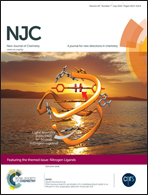A family of uranium–carboxylic acid hybrid materials: synthesis, structure and mixed-dye selective adsorption†
Abstract
Four uranyl complexes (UO2)2(pht)2(Hpac)2(H2O)2 (pht = phthalic acid and Hpac = nicotinic acid) (1), (UO2)(pac)2(H2O)2 (2), [(UO2)(CMA)3]·[H2N(CH3)2] (CMA = cinnamic acid) (3) and (UO2)2(C2O4)(μ2-OH)2(H2O)2·H2O (4) were synthesized by the reaction of UO2(CH3COO)2·2H2O as the metal source with phthalic acid, nicotinic acid, cinnamic acid or oxalic acid as the ligand. They were characterized by elemental analysis, IR, UV-vis, XRD, single crystal X-ray diffraction and thermal gravimetric analysis. The structural analysis showed that complexes 1, 2 and 3 were discrete structures, and by hydrogen bonding interactions, the adjacent molecular units are connected to form a three-dimensional (3D) supramolecular network structure for complex 1 and one-dimensional (1D) chains for complexes 2 and 3. Meanwhile, in the structure of complex 4, a tetrameric SBU (UO2)4(μ2-OH)4(H2O)4 is linked to a 2D layer through a bridging oxalic acid ligand, and furthermore extends the 2D layer into a 3D supramolecular architecture by hydrogen bonding interactions. In order to extend their functional properties, their photoluminescence, surface photovoltage and mixed-dye selective adsorption properties have been studied for the first time. Through experiments, we found that the adsorption performance of complex 3 was better than others, and the amount of adsorbed RhB was 4.22 mg g−1.


 Please wait while we load your content...
Please wait while we load your content...